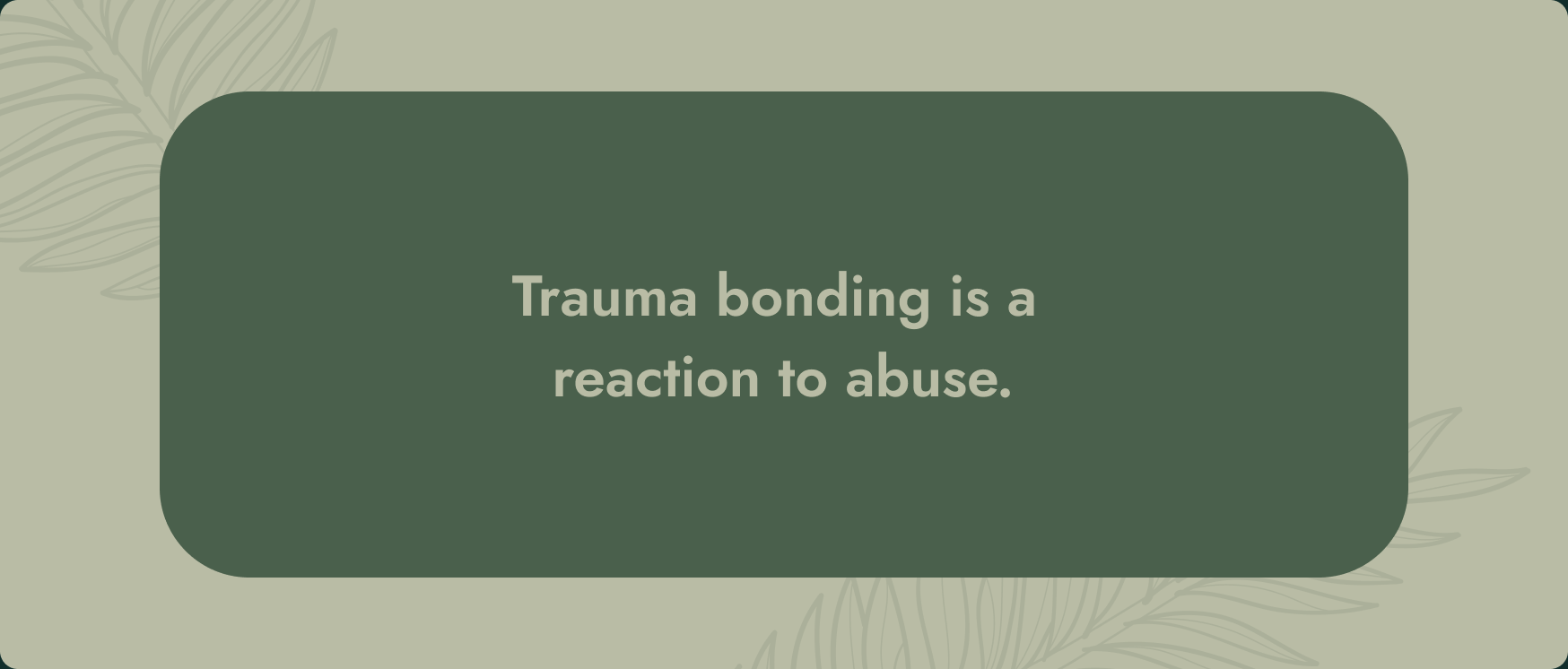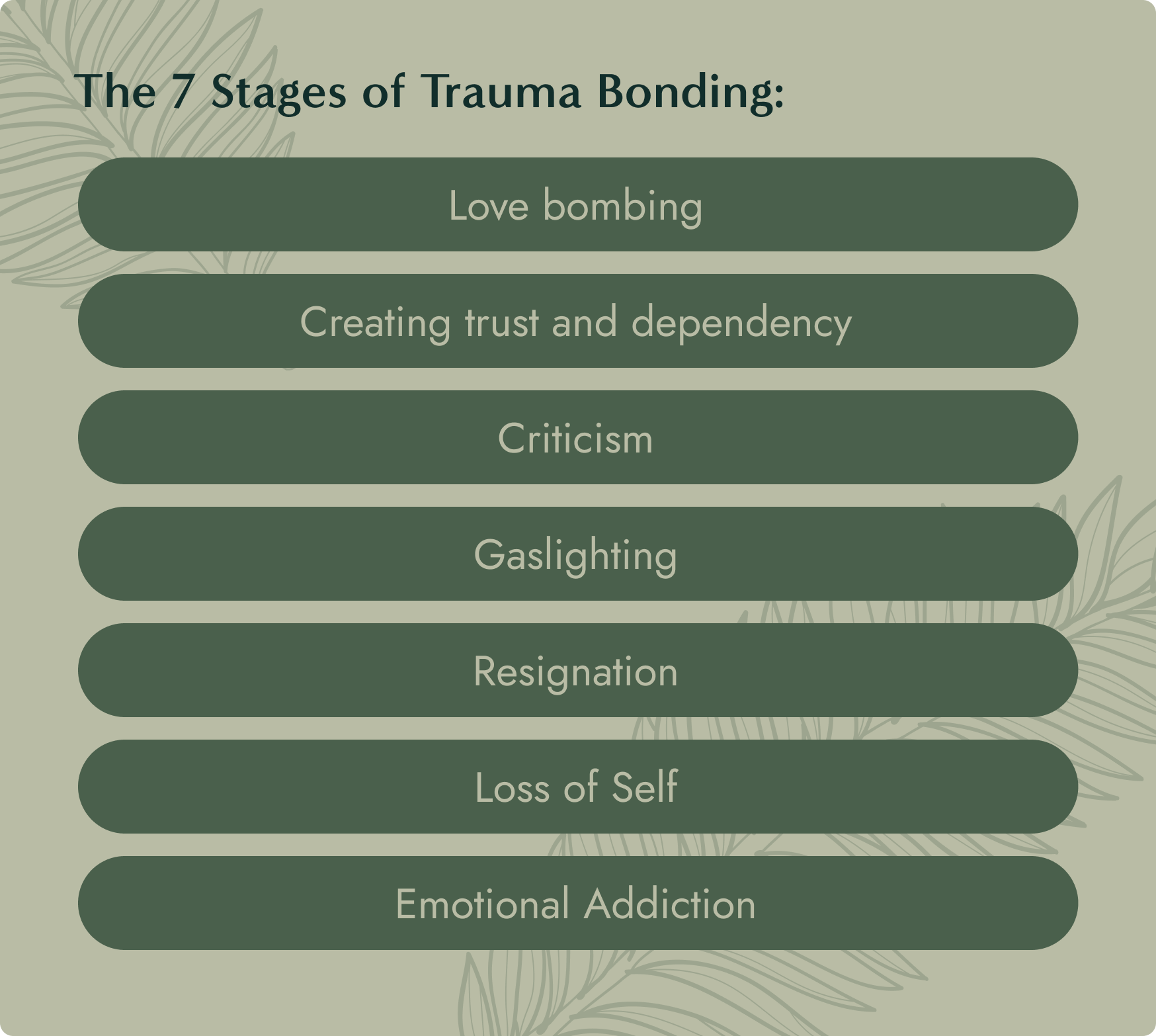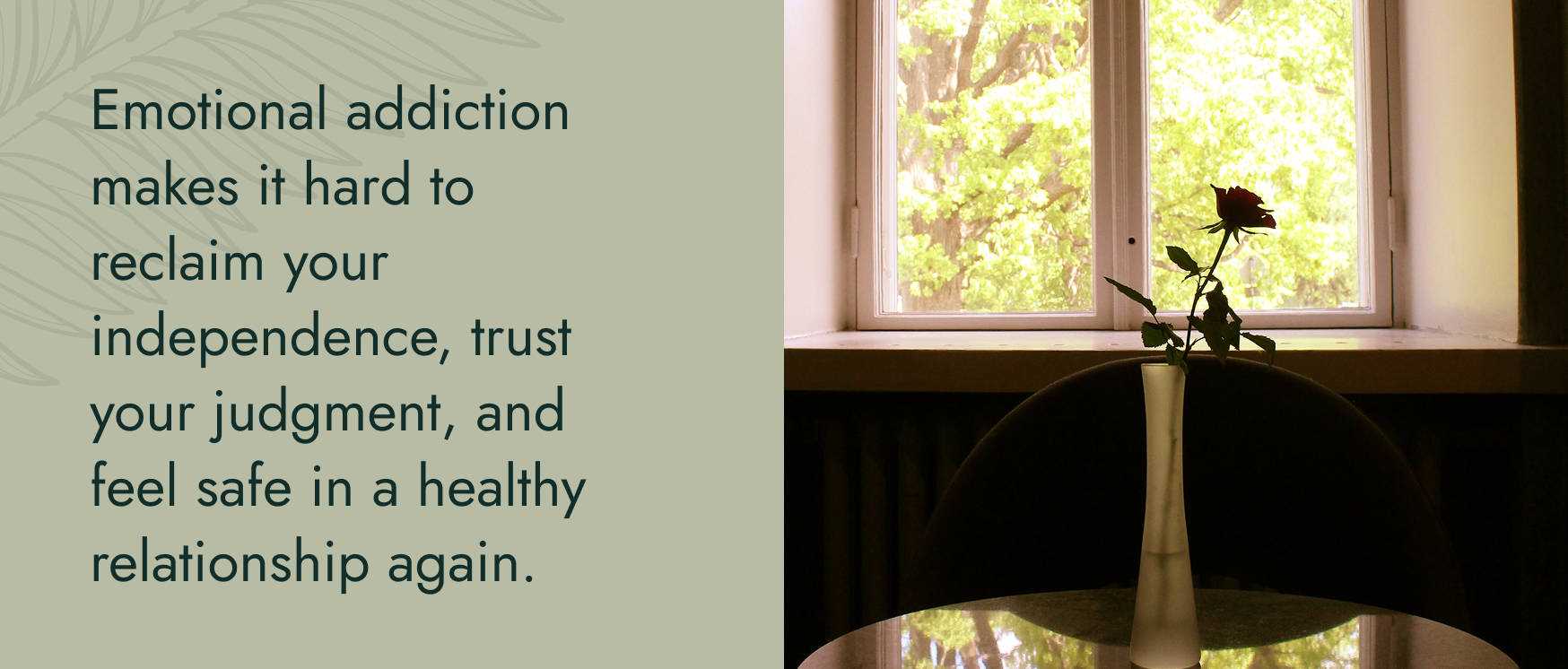7 Stages of Trauma Bonding


Trauma bonding is a term that can easily be misunderstood. From a plain reading, people might think it refers to when people with trauma in their past use that trauma as a common ground to create a relationship or friendship. Unfortunately, it’s much more insidious than that.
What is Trauma Bonding?
Trauma bonding is a reaction to abuse. This theory was proposed by Dr. Patrick Carnes in 1997. Dr Carnes created the idea of trauma bonding to refer to the relationship a person has with their abuser.
This relationship is perpetuated by the cycle of abuse and isn’t reserved for romantic relationships. It can develop between parent and child, family members, kidnapper and captive, and even cult members and cult leaders.

What Is Stockholm Syndrome?
One famous example of trauma bonding is Stockholm Syndrome, which is a term that was coined after a real-life hostage situation in which the victims refused to testify against their captors and even raised money in their defense. This is considered a form of trauma bonding because the captives’ intense emotional connection with their captor was developed as a survival strategy in the face of ongoing abuse and power imbalance.
The biggest difference between Stockholm syndrome and trauma bonding is that trauma bonding usually happens over a longer period of time, and the abuse that occurs is usually less noticeable. Stockholm Syndrome involves someone being kidnapped and held hostage.
Get Trauma Treatment at in Mesa, Arizona
Abusive relationships often cause trauma. Our team can help you resolve trauma and live the life that you deserve. Learn more about trauma treatment here at Sequoia.

The 7 Stages of Trauma Bonding
Trauma bonding takes place throughout multiple abusive cycles, and it can happen either quickly or over a longer period of time. Although the circumstances can look different for everyone, there are similar characteristics that can be found in all cases.

1. Love Bombing
The first stage is love bombing, which is a tactic used by an abuser to quickly gain trust and establish control within a relationship. Some common examples of love bombing include:
- Giving expensive gifts
- Complimenting so frequently that it feels excessive
- Bombarding someone with texts, calls, or social media posts
- Rushing milestones, like saying “I love you” or moving in together
- Making unrealistic promises
These signs aren’t always red flags that someone may be an abuser because, on their own, they can also indicate someone’s genuine enthusiasm or attachment style. The key difference is that an abuser will use these behaviors strategically to manipulate, gain control, and create emotional dependency.
2. Creating Trust and Dependency
This brings us to the next stage of trauma bonding, where the abuser begins making false promises about a future that will never happen. They may promise children, marriage, awesome vacations—anything to make the person think they’ll be around in the long run.
These promises help the abuser establish trust and dependency by creating a powerful emotional investment in the imagined future. It keeps the victim hopeful, committed, and less likely to leave, even when the abuser reveals their true nature.
3. Criticism
After trust has been established, the abuser slowly changes from affectionate and complimentary to cold and critical. They’ll begin finding flaws and picking at them, often criticizing the very things they once complimented.
During the love bombing stage, the abuser may have complimented your looks, admired your personality, and encouraged your social life. In this stage, they may make negative remarks about your body or style, make you feel embarrassed to be yourself, or try to keep you away from your friends.
To add to the confusion, the abuser will often follow harsh criticisms with grand apologies and more love bombing. They do this to train the victim using positive reinforcement, where the victim begins to associate emotional pain with affection and reward.
4. Gaslighting
Gaslighting is an emotional manipulation tactic that causes the victim to doubt their experiences and reality. In the case of trauma bonding, it’s used to make the victim doubt that they are being abused at all.
By convincing and confusing the victim into doubting their own memories, emotions, and perceptions, the abuser can now rewrite the narrative of the relationship. This makes the victim feel responsible for the problems, dependent on the abuser’s version of the truth, and less likely to seek help or leave.
Read our related article for more information on emotional manipulation.

5. Resignation
Over time, the victim comes to realize that no matter how they express themselves, the abuser will dismiss, twist, or ignore their words. At this stage, the victim will begin to resign themselves, meaning they accept that the abuse can’t be avoided.
Victims often turn to fawning to appease their abuser, which is a type of trauma response that involves prioritizing the needs and desires of others to avoid conflict. Even if they sense something is wrong or recognize the abuse, the emotional bonds and fear make it incredibly difficult to leave.
6. Loss of Self
At this stage, the victim neglects their own personal needs, desires, and sense of self to appease the abuser. Before the abuse began, the victim had their own goals, identity, and independence. Now, their identity is defined by their abuser’s expectations, moods, and demands.
It’s common for the victim to isolate themselves from their friends and family during this stage. While this is often a demand from the abuser, it can also stem from the victim’s own confusion and loyalty. Over time, victims often become dependent on their abuser and believe they're the only person who truly understands or cares for them.
7. Emotional Addiction
After prolonged abuse, the victim can actually become psychologically addicted to their abusive relationship. This is due to the ongoing cycle of abuse and intermittent reinforcement, where moments of cruelty are followed by affection, apologies, or love bombing.
During the “good times", the brain can release the same reward hormones as addictive substances. When the “bad times” come around, the brain releases high levels of cortisol, which is the same stress hormone that is released during drug withdrawal.
This emotional addiction not only makes it harder for the victim to leave, but it makes it much more difficult to reclaim their independence, trust their own judgment, or feel safe and worthy in a healthy relationship again.

Related Blogs

Types of Trauma Responses
How we respond to trauma is hard-wired into our brains, but people still respond to trauma incredibly differently. Learn more about trauma responses, including how they overlap with each other.

Signs You Are A Narcissistic Supply: Drained For Attention and Validation
Being a narcissistic supply can cause deep emotional and physical damage. Learn more about what living as a narcissistic supply means and what to do if you are one.

Navigating Toxic Relationships In Recovery and After
Toxic relationships can harm the treatment process and should be navigated or cut out. Here are some tips on how to do that.
How to Break a Trauma Bond
Breaking free from a trauma bond can be incredibly difficult, but it’s not impossible. Just like with breaking free from a substance addiction, leaving an abusive relationship can take multiple attempts, and that’s okay.
To begin breaking free from a trauma bond, you should:
- Recognize the Abuse — The first step to breaking trauma bonds is recognizing the harm the relationship is causing and acknowledging that change is needed.
- Focus on the Present — You might have good, happy memories from the relationship, but the past shouldn’t keep you present in an abusive situation.
- Cut Contact and Get Support — Leaving is hard, especially with isolation and emotional ties. Reach out to family, friends, and a therapist—they can help you rebuild and heal.
You deserve peace, safety, and a future free from abuse. Healing is possible, and support is available—you don’t have to go through it alone.
Read our related guide for more information on how to heal from a trauma bond.
Can I Fix A Trauma Bond Relationship?
It’s rare for trauma-bonded relationships to be “fixed”. It requires everyone involved to have a willingness to change, and in many cases, the abuser may not even consider their behavior to be abusive.
You cannot heal your abuser, and it’s recommended that you leave abusive relationships.

Reclaim Your Life From an Abusive Relationship
The lack of support many victims face after leaving an abusive situation is one of the biggest hurdles victims face. Seeking help through counseling is a great way for people to find support. Therapy guides people to positive talk and helps them rebuild their self-image.
Sequoia Behavioral Health can help you recover after these relationships by offering tools to help you re-establish healthy relationships that may have been lost while being manipulated. We’ll also treat any underlying mental health problems that you may have, such as low self-esteem, attachment trauma, or depression.
Reach out today to connect with a mental health professional and begin your healing journey.
Learn More
EMDR
EMDR helps people relive and correctly process traumatic memories. Reach out to Sequoia Behavioral Health today to start your healing journey.
Group Therapy
In group therapy, individuals can learn, grow together, and experience meaningful support through psychoeducation, recreation, and community development.
Accelerated Resolution Therapy
Accelerated resolution therapy helps trauma victims reframe painful memories. Sequoia Behavioral Health in Mesa, AZ uses ART during trauma treatment.
Your journey at Sequoia starts with simple admissions process where we learn more about you, your concerns, and your goals. Learn more about how we help you get started on your path to mental wellness.


